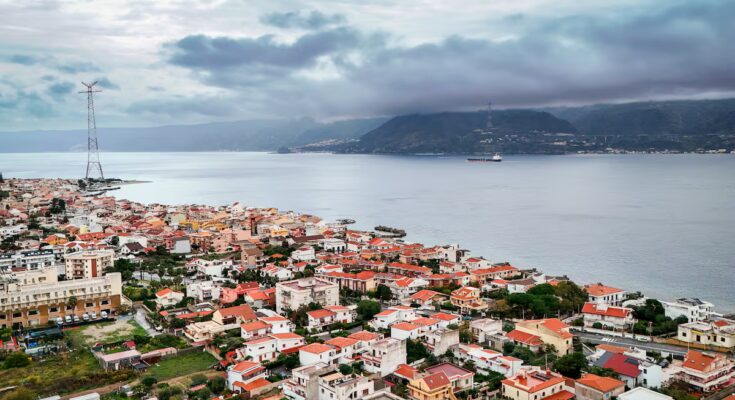When Cettina Lupoi bought a house with her husband 23 years ago, she believed she had finally realized a dream: living in a small chalet in a quiet new residential complex in one of the most beautiful areas of Messina, Torre Faro, an ancient fishing village 10 kilometers north of the center of the Sicilian city, with a privileged view of the Strait, the stretch of sea just over three kilometers long that separates the island from the mainland. Lupoi’s joy was short-lived. “Not even a day had passed since I signed in front of the notary, when I learned that the entire area was included in the expropriations planned for the construction of the bridge over the Strait”, says this retired literature teacher, sitting in the living room where family photos and memories have been accumulating ever since despite the sword of Damocles with which they have lived for almost a quarter of a century.
The house is located not far from where one of the two pylons of the suspension bridge would emerge, which would be the longest in the world, a colossal work that has become the most discussed and divisive in Italy. A project that has been talked about for decades, forgotten by one government and recovered by the next, in a dance that has done nothing but increase distrust towards an infrastructure whose sustainability – financial, structural and environmental – continues to be debated. “Berlusconi was at the head of the Government. I said to myself: ‘They’ve been talking about it for 50 years, they won’t do it…’. Then in 2011, when he left the scene, the work stopped. We breathed a sigh of relief without knowing that years later Salvini would come to relaunch the project in a very aggressive way”, says Lupoi, summarizing a chronology that began with a competition of ideas within the late Sixties and whose last chapter is starring the minister of Transport and Infrastructure, Matteo Salvini, the first supporter of one of the star projects of Giorgia Meloni’s government.
The reactivation of the works, which the technical government of former European Commissioner Mario Monti had set aside in 2012, was one of the significant measures of the first semester of the Meloni executive in March 2023, with a law decree that resurrected the public company Stretto di Messina, created in 1981 and until then in liquidation. It also recovered the project prepared in 2011 by the Eurolink consortium, led by the Italian Webuild and of which the Spanish Sacyr holds a 22.4% share. Its final version, an update of the original project, received the approval of the Interministerial Committee for Economic Planning and Sustainable Development last August, the body that evaluates and approves large public works. “A historic day”, Salvini defined it, with the promise to start the preliminary works by the end of the summer. A day of anguish for Lupoi and the owners of over 450 homes, 300 on the Sicilian side and 150 in Calabria, on the other side of the Strait.
“We notified many of the owners of the houses subject to expropriation thanks to these maps. Not even they knew”, says Daniele Ialacqua, while running his hands over large sheets of paper, in the place where the No Ponte Capo Peloro Committee meets, one of the most active groups. The projects show how the works will cross the entire area, characterized by two brackish lagoons, a nature reserve. “It is a protected territory. This is why, for example, it took me years to install solar panels on my house. There are restrictions for the protection of birds and the ecosystem of the lagoons. There are also indications on the color that the houses must have. Now they tell us that right here they can build a 400 meter pylon”, says Ialacqua. Exactly 399 meters is the height of the two main structures of the suspension bridge, with a single span of 3,300 metres, three lanes in each direction and two railway tracks. The pylons would measure double the size of the high voltage towers that once connected the two banks of the Strait and which now remain a vestige of industrial archaeology.
While Lupoi and many others have recently joined the “No Bridge” movement, Ialacqua, a high school teacher and former environmental councilor of the Municipality of Messina, started 40 years ago. “With the environmentalist association Legambiente we made the first initiative in 1986. The movement reached its peak in 2006, when we managed to gather more than 20 thousand people. That year Berlusconi lost the elections. Now we are in the ‘third wave’ of protest. There are always between 5,000 and 10,000 people, which is a lot here, where there are no mobilisations even when there are they take away the water.” comments. The reference to water is not trivial, because it is one of the structural deficiencies of the island: «Five million liters of water per day will be needed to build the bridge, and here the delivery only takes place between 6 and 11 in the morning».
The next date marked in red on the calendar is November 29th, when a large national demonstration is planned in Messina. It’s the last mile of the battle against the bridge. By then we should know the details of the decision of the Court of Auditors, which at the end of October did not validate the plan approved by the Government in August, paralyzing in fact the work. The resolution is not binding and the Government can force approval of the project, but the Court’s observations are not irrelevant: from the emergency procedure that bypasses environmental regulations to the increase in the total cost. The current figure, entirely financed with public funds, triples the 3,880 million approved in 2006, when the work was awarded, which could represent a violation of European directives, which require a new tender when the increase exceeds 50%. The Government guarantees that the bridge will be built, Salvini says he is “determined” and sets the start of work in February.
“I have the impression that they are making fun of us, that they just want to advertise themselves,” says Giovanni Sottilaro. He is the owner of the Boccaccio bar, on the seafront of Cannitello, a hamlet of the municipality of Villa San Giovanni, on the Calabrian side of the Strait, the area where the other pylon of the record-breaking bridge would be built. Among the houses from which “no to the bridge” flags hang, in an area also subject to expropriations, Sottilaro, who is 70 years old and started working behind the bar when he was nine, is in favor of the bridge. On site there is a framed print of the project, dated February 2003, a gift from the external relations office of the Stretto di Messina company. “My father was already talking about it. It would be a wonderful job, which would give our children a future. And if I have to go, I will go,” he says. The same defends his son Francesco, 31 years old. “The young people are leaving here, there are about five or six of us left on my farm. This would provide work. The only fear is that they will start it and not finish it”, he says, repeating a refrain common to many of those who support the project.
The mistrust is based on the same reason why many declare themselves in favor of the bridge: after so many broken promises for the development of two of the poorest regions in Europe, if it were built, the bridge would be proof of the state’s attention, a symbol of rescue. But the memory of the past fuels the fear that, as some repeat, “then the pilón will remain alone”. A handful of kilometers from Villa San Giovanni are ecomonsters like the ruins of Saline Joniche, a chemical company financed in the seventies with public funds and which remained operational for only two days. The heritage is an entire factory that has been rusting for decades and a high chimney which, from the road, breaks the view of Sicily and the Etna volcano. The work was part of a vast package of public investments that promised development and jobs in a land that was experiencing massive emigration towards Northern Italy and Europe which has not stopped since then. The unfinished houses, with exposed iron, which dot the landscape of the provincial centers are now the emblem of the exodus.
“I question the bridge from a social and useful point of view. But there is a part of the population that sees in it a response from the State to the shortcomings that have existed, as if as long as something is done here, everything will be fine, without evaluating the negative and devastating impact it will have on the territory. It is the great farce of progress. Just think that 2 billion from the European Cohesion Fund were used to finance the bridge, money that was used for roads, schools, hospitals, which is what we really need here”, says Daniele Cartisano, social worker and president of the local section of Legambiente, the association which together with others has presented several appeals against the bridge.
Also the Town Hall of Villa San Giovanni, from where most buses now depart. ferries which now connect the two banks of the Strait by sea, has filed a lawsuit for the environmental impact of a project which, according to the mayor Giusy Caminiti, is already old. “In the update there is no study, no new scientific evidence. It is the same project from 2011 and some parts are from 2004. Already in a 2021 report from the Ministry of Transport (in the years of the Mario Draghi government) it was proposed to study alternatives to the current solution, such as the bridge with more spans and with a location further south. So it is not true that there are no alternatives”, says Caminiti. “What we want is that there is not a propagandistic approach, but rather a technical-scientific one”, adds this jurist who since 2022 has been at the helm of a municipality that the previous administration declared financially bankrupt and which is marked, like the rest of the province, also by organized crime.
But if in the past the risk of mafia infiltration was one of the “no to the bridge” arguments, now Caminiti rejects that logic: “There is a new generation of administrators between 40 and 50 years old who want to demonstrate that it can be done here. And we face everything, including an incinerated excavator in a two million euro project… So if it wants to build the bridge, the Government will have to show us too. But then there are all the other problems…”. Caminiti then goes on to list them: the studies on the high seismicity of the area; the fact that the expropriations would begin on the basis of the definitive but not executive project which, in the Government’s intentions, will take place in phases; projections of passenger and freight flows, in sharp decline; the possibility of encouraging sea transport, providing the city with a more modern and efficient port; and the crucial issue of missing projects on the rail network…
The mayor is worried about the general impact of the works on a city of 12 thousand inhabitants which, paradoxically, runs the risk of becoming isolated and disappearing: “The Government says that the inauguration will be eight years away, but experts assure that it will take at least 30”.
Months ago, the news of cuts to the construction of high-speed rail works in Calabria sparked quite a bit of controversy. In Sicily, the fact that, despite promises, 85% of the railway network is single track and dates back to the end of the 19th century, is experienced as an open wound. Hence the distrust that radiates from the debate around the bridge. To explain it, Cettina Lupoi paraphrases Hannan Arendt: “When power tells you so many lies, it’s not to make you believe that a certain thing is true. They do it so that you don’t believe anything. A people who can’t distinguish what is true from what is false is particularly vulnerable. You can do whatever you want with it. Now, sometimes, I feel like this: I no longer know who to believe.”



